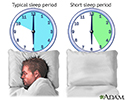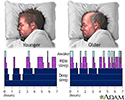Natural short sleeper
Sleep - natural short sleeper
A natural short sleeper is someone who sleeps a lot less in a 24-hour period than is expected for people of the same age, without being abnormally sleepy.
Causes
Although each person's need for sleep varies, the typical adult needs an average of 7 to 9 hours of sleep each night. Short sleepers sleep less than 75% of what is normal for their age.
Natural short sleepers do not restrict the number of hours they sleep on purpose. Scientists believe that genetic variation allows natural short sleepers to function well with less sleep than normal.
Natural short sleepers are different from people who chronically do not get enough sleep because of work or family demands, or those who have medical or mental health conditions that disrupt sleep.
Symptoms
Natural short sleepers are not overly tired or sleepy during the day.
Treatment
No specific treatment is needed.
References
Avidan AY. Sleep and its disorders. In: Jankovic J, Mazziotta JC, Pomeroy SL, Newman NJ, eds. Bradley and Daroff's Neurology in Clinical Practice. 8th ed. Philadelphia, PA: Elsevier; 2022:chap 101.
Landolt H-P, Dijk D-J. Genetics and genomic basis of sleep in healthy humans. In: Kryger M, Roth T, Goldstein CA, Dement WC, eds. Principles and Practice of Sleep Medicine. 7th ed. Philadelphia, PA: Elsevier; 2022:chap 16.
Mansukhani MP, Kolla BP, St. Louis EK, Morgenthaler TI. Sleep disorders. In: Kellerman RD, Rakel DP, Heidelbaugh JJ, Lee EM, eds. Conn's Current Therapy 2023. Philadelphia, PA: Elsevier; 2023:794-809.
Natural short sleeper - illustration
Natural short sleeper
illustration
Sleep patterns in the young and aged - illustration
Sleep patterns in the young and aged
illustration
Review Date: 10/10/2022
Reviewed By: Allen J. Blaivas, DO, Division of Pulmonary, Critical Care, and Sleep Medicine, VA New Jersey Health Care System, Clinical Assistant Professor, Rutgers New Jersey Medical School, East Orange, NJ. Review provided by VeriMed Healthcare Network. Also reviewed by David C. Dugdale, MD, Medical Director, Brenda Conaway, Editorial Director, and the A.D.A.M. Editorial team.



